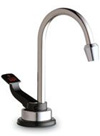Unlike what we more commonly refer to as hot water supply in the home (with typical delivery in the 120°F to 140°F range), these systems deliver at near-boiling temperatures (190°F+). The super-heated water they provide is ideal for instant beverages, soups, hot cereals, pastas, thawing frozen foods, loosening baked-on crud, etc. (Note: though the terminstant hotis often used in a rather generic way for such systems, technically, that is a registered trademark of KitchenAid - it has become a Kleenex kind of term in our biz.)
When these products came onto the scene back in the late 60's and early 70's, there was a lot of excitement that they would become "the next garbage disposer" in terms of standard equipment on the sink. It never happened. Why this is so isn't entirely clear, but one thing is - it hasn't been because the products haven't delivered on their promise of utility and convenience. When you talk to folks who do have one installed in their home, you will usually get a very positive review, including, "I wouldn't have another kitchen without one." Interestingly, I often get those remarks from someone who didn't intentionally select one, but rather, inherited one with the purchase of a home.
I sometimes hear arguments against hot taps based on the availability of microwave ovens in most kitchens today. Sorry, but that's notinstant. While getting a hot beverage ready to go in two or three minutes may have sounded good a generation ago, folks today aren't as willing to wait for things to happen. And for those who may think that nuking water is safer than using a hot tap, there are growing reports of boiling water flashing up out of containersafterremoval from the oven. See these reports that Mario found online recently:
http://www.alive.com/3833a2a2.php?subject_bread_cramb=449
http://www.instructables.com/id/Hidden-Danger-Microwave

So what's the problem here? Why is this category still stuck well below the million mark in annual unit sales, when disposer numbers are up there in the eight-figure neighborhood with kitchen sinks and faucets?
One obvious factor is lack of exposure. It amazes me how often I meet people - even industry people - who still don't know there is such a thing as an instant hot. In asking manufacturers about this over the years, I sometimes get an explanation that goes something like this: "Well, the category isn't a big one for us compared to our core product lines, so we only devote a proportional amount to our advertising budget." Anybody see something wrong with that picture?

Though there were minor refinements to these constructions over the years, the first truly upscale dispensing head was designed by my firm for Franke back in the late 80's. Dubbed the "Little Butler," this was the first all-brass design with decorative styling and available in a variety of finishes. The success of this introduction then triggered numerous designs using similar constructions from other manufacturers, for the most part using vertically oriented actuating levers.
I might add that as sales for these upscale models grew, there has been a definite swing from "hot only" to hotandcold models. Cold, in this case, can mean several things - cold, as in ambient cold (same thing you get from the primary faucet on the sink) - chilled (coming from an under-counter chiller) - or either of those combined with a filter.
Next on the upscale scene came even more designs appealing to the consumer, in this case, looking more like decorative bar faucets. These models also brought us improved valving, in the form of ceramic cartridges.
(The servicing of many of the vertical lever designs often requires the dexterity of a puzzle expert and a third hand, by the way.) One drawback of the hot and cold models of this genre, however, has been their lengthy linear footprint on the faucet deck, sometimes causing interference with other components.
